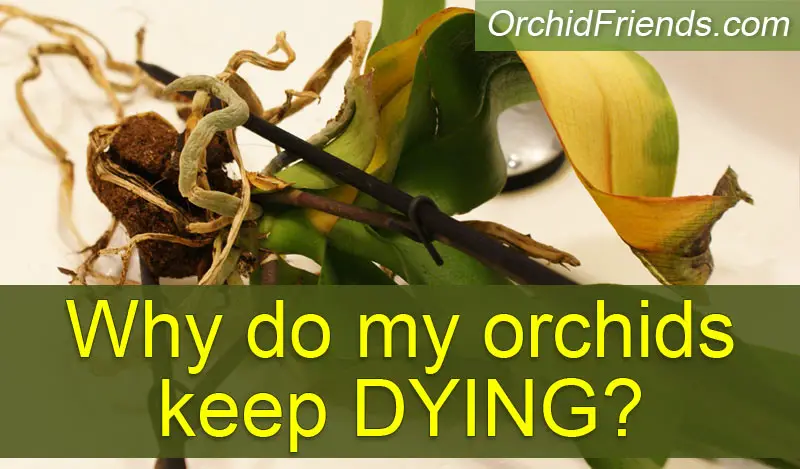
** This post is written and edited by a human being **
If I got an orchid for every time someone asked me why do their orchids keep dying, I’d have a full-blown orchid garden by now! Even though Phalaenopsis orchids are actually pretty low maintenance, most people new to orchids fail to keep them alive.
Of course, this is understandable, taking into consideration these plants don’t come with instruction manuals. And therefore people simply don’t know how to care for them, even if they had good intentions.
So let’s discuss below different reasons why your orchids might be dying.
So why are your orchids dying? Different things can be causing this, like over-watering or under-watering, lack of proper drainage and air holes in the pot, too hot or too cold growing environment, even hidden pest problems or undiagnosed plant diseases.

Before we discuss these different possibilities in more detail, I’d like to say a few words.
All house plants (not just orchids) have their own needs – some thrive in the shade while others enjoy sun; some need plenty of watering while others survive with very little water. With all plants, we need to learn what their individual needs are, which after caring for them becomes easy.
Furthermore, and I repeat this over and over again, Phalaenopsis (‘Moth’) orchids are unique compared to ‘normal’ houseplants. This is due to the fact that they are ‘epiphytes’, which are plants that do not grow on the ground in soil, as typical terrestrial plants do. Instead, they grow higher up, attached to diverse growing surfaces, such as tree trunks and rocks.
That’s why their care is different from ‘normal’ houseplants – you can’t just repot them in normal potting soil and water as usual. This would be a sure way to kill your orchid.
Once you’ve understood how Phalaenopsis orchids “work”, it will help you understand their needs, and that way adjust your care accordingly.
On that note, let’s discuss in more detail what might be killing your orchids!
Over-watering & Under-watering of your Orchid
When a person comes to me to ask for help when their orchids are dying, I first suspect either over-watering or under-watering. This is because insufficient watering is the #1 cause of people’s orchids dying!
As I mentioned above, these plants are ‘epiphytes’. Therefore they would never stand in wet growing medium for long periods of time. In nature there would only be a “tide” of water, every now and then, leaving the growing surface moist. It will then start to dry out until the next tide of water. So it’s cycles of wet and dry – not just wet or just dry.

So that’s what you need to mimic in home conditions too; give the roots a flush of water, and then let the potting medium dry. Once almost all dry, water the orchid again. This way you will never over- or under-water your plant, but give them exactly what they need and, more importantly, when they need it!
Over-watering happens when more water is just poured to the orchid without even checking if the potting medium is dry yet. Just water the orchid while watering all the other house plants. And I get it – how can people water their orchid correctly if they haven’t been told how to do it in the first place! They’ll just apply “normal” house plant rules to them.
When you check if the orchid needs watering again, it’s not enough to look at the top bark pieces (or whatever type of potting medium you’re using) – this is because if you lift up the pot, which in most cases is a clear plastic pot, you’ll see the bottom part of the medium takes much longer to dry out than the top. And so if the bottom part is still wet/moist, then your orchid doesn’t need watering yet!
Constant standing water in the decorative pot is another killer. If I’ve gone to inspect someone’s orchid and lifted the inner pot up, I often find a lot of water standing in the decorative pot! So always pull up the whole inner pot; see if the medium is dry yet, and also make sure there’s no leftover water standing in the decorative pot for long periods of time.
If you’re not overwatering, then maybe you’re underwatering. Some people simply forget to water their plants, orchids or not, full stop. And okay, that’s an entirely different discussion. One should, of course, always remember to give water to their houseplants—that’s what they live off!
During cooler seasons, Phalaenopsis orchids don’t actually need constant watering. During these times I can go even 3 weeks without watering my orchids! However, during warm seasons it’s a different matter; the orchid needs to be watered more often. Maybe once a week, maybe every 3-5 days – it depends on several factors. So once again; you need to check the pot and potting medium! Does the medium and the roots look extremely dry and brittle? That’s dehydration, a dehydrated root system due to under-watering.
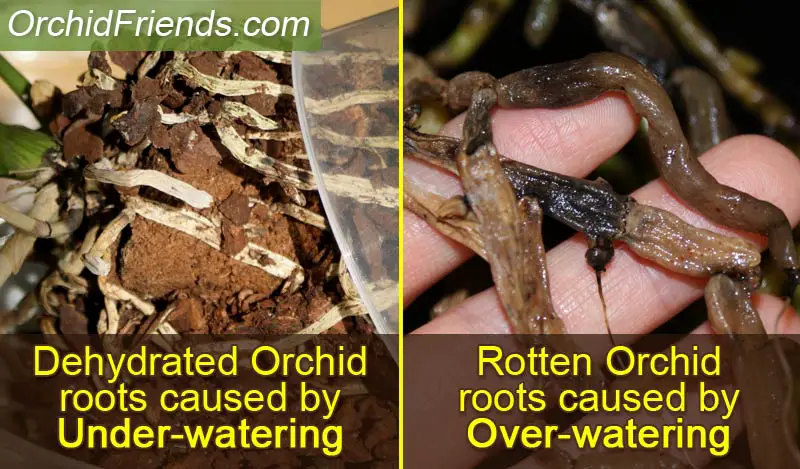
Different seasons require different watering regiments, so you need to keep an eye on your orchids. If you accidentally let your orchids stand for weeks, or even months, without watering, then YES, that’s why your orchids are dying. So find the right balance, and keep adjusting according to the seasons. Once you get the hang of it, it’s really simple and your plants will thrive for years to come!
More tips for How to water your orchids properly; Click here!
Lack of proper Drainage & Air holes in the Orchid pot
This goes hand in hand with your watering. As we discussed above how the orchid’s root system needs a “flush of water” (instead of constant standing water), it makes sense that for this to happen the pot needs to have proper drainage. In other words, ensure that there are sufficient holes in the bottom of the pot.
You can check this when you water your orchid next time; does a lot of water get trapped inside the pot, and stays there for a longer time? In this case I’d recommend you to either repot your orchid using a new orchid pot with better drainage holes in them. Or you can reuse the old pot, but make more holes in the bottom of it. You want to make sure water can easily get out of the pot when you water your plants!
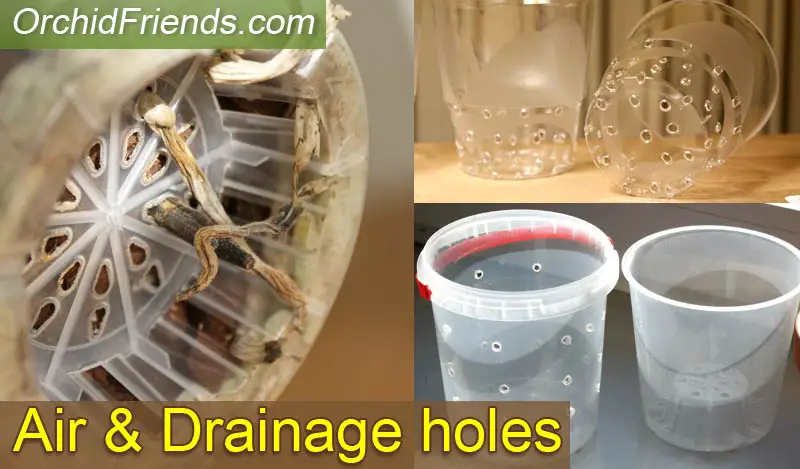
Air holes, which are holes around the sides of the orchid pot, provide a good air circulation inside the pot. (Remember; the roots need air to breath!) They go hand in hand with the drainage holes, but the difference is: you can’t have a pot without drainage holes, yet air holes around the sides aren’t always needed.
When the orchid potting medium is breathable enough as it is, and there are good drainage holes in the bottom of the pot, additional air holes aren’t a necessity.
But if the orchid potting medium seems to take a long time to dry, then it’s good to add air holes to your orchid pot. This way you help the potting medium to dry properly (and quicker) in-between watering, which in turn helps the roots stay in good condition.
Too much moisture and lack of proper airflow inside the pot, quickly results into the roots to suffocate, which quickly leads to root-rot. This will ultimately kill the whole root system. So in addition to proper drainage holes, see if you need to add some air holes on the pot too!
I use a soldering iron to make holes to my plastic pots. It’s so quick and easy, and makes clean holes. The only minus is that the melting plastic smells horrible – it’s toxic… I have pet birds, so I never use the soldering iron close to them! I go on the backyard or in the storage room to do it.
If you don’t have a soldering iron, you can also use nails – hold a nail with a tool (or thick gloves) and warm the end of it in fire or on a hotplate. Heat up the nail and then burn it through the plastic. I’m not sure how many holes you can do at one ago, but heat the nail again as needed.
Third option is a drill! If you have the right head for the drill and the plastic is thick enough, then this is a good method as well. (And no toxic fumes from the melting plastic!) Just remember that if the pot is made of thinner plastic, then it can easily break when drilled through.

Too HOT or too COLD for your house orchid 🥵🥶
If you know you have the watering under control, and the pots have enough drainage and airflow, then the next thing I’d suggest you to consider is; the growing temperatures.
Do you keep your orchids by the window even during hot seasons? Are they in beaming sun? Or alternatively, are they exposure to cold draft and cold temperatures?
With Phalaenopsis orchids you want to avoid any extremes – too cold or too hot. Even though in nature they grow in rainforests, they still can’t handle scorching hot. And freezing temperatures is something they’d never experience in the wild!
It doesn’t mean that you can’t keep orchids if you live somewhere with very cold winters. If the indoor air in your home is warm enough for you, then it’s also warm enough for your orchids!
And the same goes with heat; if it’s scorching hot outside and the sun is beaming through the window – that would be uncomfortable for you as well to be standing in!
So this could be killing your orchids too; either too cold OR too hot growing conditions. In both cases, move your orchids away from the window to avoid extreme weather conditions.
Hidden pest problems killing your orchids
I had this happen to my orchids a few years ago. I was watering my orchids correctly, keeping them in right temperatures – yet suddenly, the orchids started to collapse and die one by one! I was confused and didn’t know what to do.
I inspected the orchids and didn’t see anything out of the ordinary. It was a mystery what was going on.. But I soon found out something had been lurking in the plants! I just didn’t know what signs to look out for. In my case it was false red spider mites that had somehow been brought to the house (I suspect from the shop with a new orchid).
False red spider mites are microscopic. In the early stages of infestation it’s really hard (/impossible) to detect them! And the worst part is they quickly multiply and start to spread to the surrounding orchids too. And soon, you have a nightmare at your hands!
With my orchids, by the time the first orchid dropped all its leaves and died, it was already hit by the mites heavily. That’s why you want to catch the pests as early as possible, before too much damage has been done!
It’s not just false red spider mites that can hit your house orchids. Other nasty pests to look out for are Mealybugs (‘Mealies’), Scale, Thripe. Also ants and snails will kill your orchid.
Because not all pests are visible to the bare eye, I recommend you to purchase a magnifying glass! If your orchids have been dying and you know it’s not down to the first few factors we discussed above, then this option is a possibility!
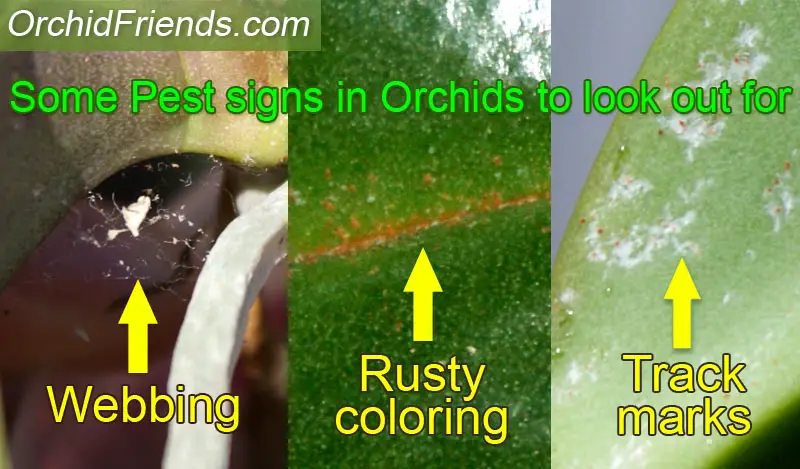
Inspect your orchid with a magnifying glass; look for live pests, any movement, eggs, webbing, even feces of the pests. Also missing plant tissue, which the pests have eaten away. Just look for anything out of the ordinary.
Undiagnosed diseases killing your orchids
Another insidious killer of your orchids could be undiagnosed viruses. Yes, orchids can carry viruses and they can spread from orchid to orchid. (Don’t worry; they’re not contagious to us humans!) So if your orchids have been mysteriously dying, and you’ve checked everything else, then it could well be that your orchids are under attack!
I won’t go into too much detail about different viruses in this article, but look out for any strange coloration or yellow circles on the leaves of your orchids. If you see something that looks strange to you, then it’s good to look further into it.
Sadly there’s no cure for orchid viruses at current time, so if that’s what’s killing your orchids, then you have no other option but to discard the infected plants. Always wash your hands in-between handling different plants, and disinfect scissors when trimming your orchids to prevent any possible viruses from spreading!
FINAL THOUGHTS
I hope this article has helped you to determine what’s killing your orchids! It’s always upsetting when plants die, but luckily it doesn’t mean you can’t fix the issue – whatever it may be. Once you diagnose the problem, you can then prevent your other orchids from the same destiny!
As mentioned above, the biggest cause of death in Phalaenopsis orchids is related to watering – too much or too little. So I would always start with that first, before looking into other options. And in a way I hope it’s the insufficient watering that’s killing your orchids, because that’s so easy to fix! To tackle pest issues and viruses is way more discouraging!
If you have any questions or comments, please leave them in the comment section below – I’d love to hear from you! You’re welcome to share stories about your orchids dying – what caused it, and did you manage to fix the problem?
Thank you for reading! Until next time, orchid friends… 😊

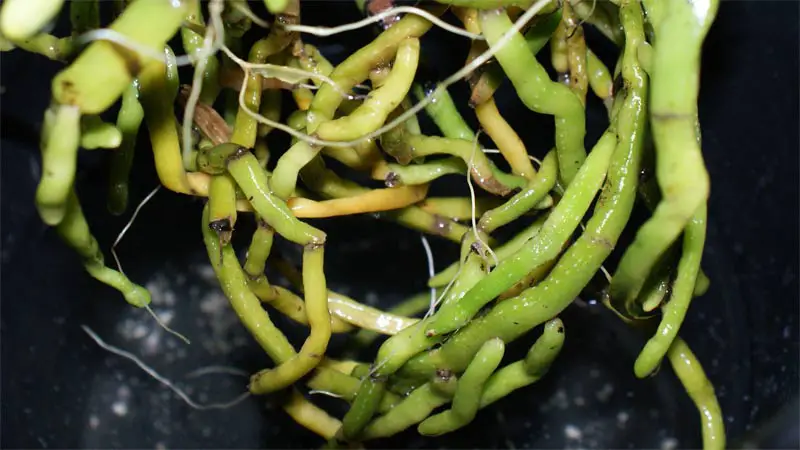


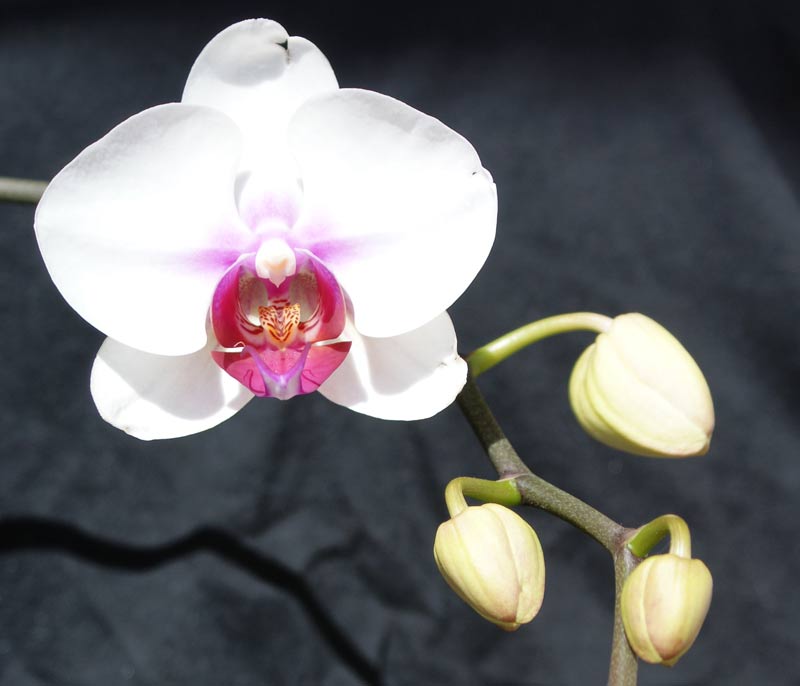
This is awesome information. I read some about the watering and definitely I did not water mine correctly. I will read more. Thank you Irene.
Hi Becky! Glad you learned something new here!
The correct watering is definitely the key to keeping them alive and thriving.
Love from Irene
My orchid instructions said to give it 3 ice cubes/week and it’s been dropping dry flowers lately. I found that it has an inside pot with drainage, so gave it a good watering and will let it dry out a little before returning it to the outside pot. I think it wasn’t getting enough water. I’m glad I read this article & thanks!
Hello there!
Yes, it could be your orchid hasn’t gotten enough water. The 3 ice cubes a week is such a vague instruction – an orchid’s need for water changes from season to season. Now during warmer days, they need more water. And vice versa. So just keep an eye on the potting medium, and water as needed! (As soon as it’s almost totally dry, water again)
It’s normal for old flowers to dry out and drop, but of course make sure it’s not due to lack of water or too high heat.
All the best to you and your orchid, and thanks for your comment. 😊
/Irene